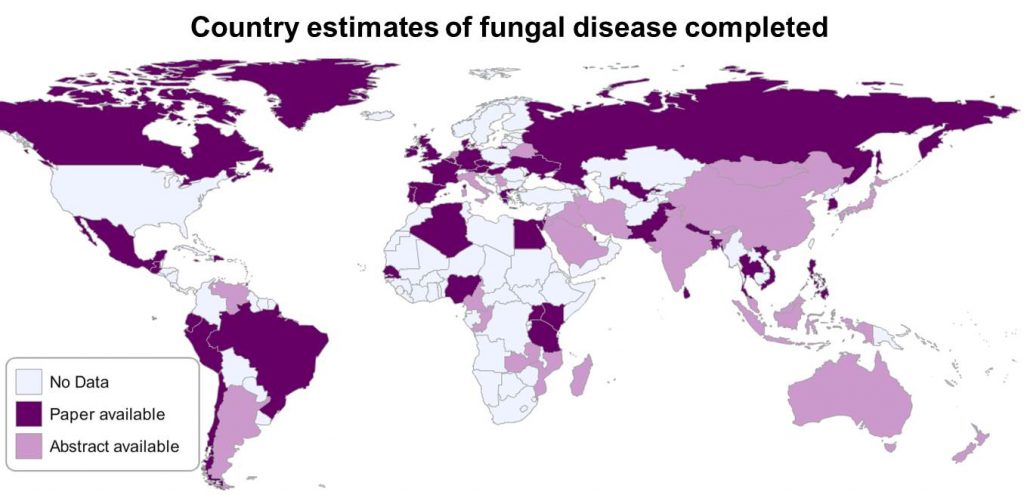Estimates never before attempted show the number of people affected by serious fungal diseases in 14 of the worst affected countries across the globe have just been published *.
Experts believe they give a stark reminder of the huge disconnect between the lack of fungal public health programs worldwide and the wealth of scientific research information on fungal disease now available.
In a themed issue of journal European Journal of Clinical Microbiology and Infectious Diseases, the number of people affected by serious fungal diseases has been estimated for 832 million people in 14 countries in Asia, the Americas, Europe and North Africa. These estimates show that between 1.8-3 per cent of the population of each country are affected by some of the most serious types of fungal disease, which can cause chronic illness and death in the most extreme cases.
The countries scrutinised are Pakistan, Bangladesh, South Korea, the Philippines, Thailand, and Uzbekistan, Ecuador, Canada, Peru, Guatemala, Chile; Portugal and Algeria and Egypt.

Several individual estimates are completely new including:
- The rate and number of fungal keratitis in Pakistan and Egypt – 44/100,000 and 14/100,000 or 80,500 and 11,550 cases respectively annually,
- 1.5 million Portuguese develop a cutaneous fungal infection each year,
- A high prevalence of chronic pulmonary aspergillosis in Bangladesh (48/100,000 – 20,720 affected) and in South Korea (22.4/100,000 – 10,750 affected) because of high TB rates,
- High rates of candidaemia in Pakistan and Thailand with 21 and 14/100,000 infected or 38,750 and 8,650 patients respectively each year,
- More disseminated histoplasmosis than cryptococcal meningitis in AIDS in Ecuador, with 1,100 cases,
- Very high rates of fungal asthma in Canada, with over 300/100,000 affected,
Professor David Denning of the University of Manchester and Global Action Fund for Fungal Infections (GAFFI) stated: “Having started this program of country by country estimates of the number of people affected by serious fungal diseases in 2012, we have now published 43 peer-reviewed papers and another 25 abstracts covering 5.6 billion people. We have applied similar methods for each country, and identified numerous key gaps in knowledge. I am very grateful to my many co-authors who have made so many key contributions to get this far.”
Fungal diseases have been generally neglected by public health in most countries and the global health community. Denning also penned an editorial entitled: “Calling all Public Health Mycologists” to emphasise the many missed opportunities to address the estimated 1.6 million deaths from fungal disease annually, and the >300 million affected by serious fungal diseases.
The burden estimates published utilised similar methodology developed as part of the LIFE program [en.fungaleducation.org] in all papers. The largest burdens are always recurrent vulvovaginal candidiasis and ‘fungal asthma’ (ABPA and SAFS). AIDS and TB-related diseases reflect the burdens of these problems in each country and how well HIV is treated. Several countries from South America and South East Asia have substantial problems with endemic fungal diseases.
A key goal of the Global Action Fund for Fungal Infections (GAFFI) is to document the burden of fungal disease across the world. These papers are an important public contribution to that policy objective.
Algeria, Chekiri-Talbi, Eur J Clin Microbiol Infect Dis, 2017;
Bangladesh, Gugnani, Eur J Clin Microbiol Infect Dis, 2017;
Canada, Dufresne, Eur J Clin Microbiol Infect Dis, 2017;
Chili, Duarte, Eur J Clin Microbiol Infect Dis, 2017;
Ecuador, Zurita, Eur J Clin Microbiol Infect Dis, 2017;
Egypt, Zaki, Eur J Clin Microbiol Infect Dis, 2017;
Guatemala, Medina, Eur J Clin Microbiol Inf Dis 2017;
Korea, Huh, Eur J Clin Microbiol Inf Dis, 2017;
Pakistan, Jabeen, Eur J Clin Microbiol Infect Dis, 2017;
Peru, Bustamante, Eur J Clin Microbiol Infect Dis, 2017;
Phillipines, Batac, Eur J Clin Microbiol Infect Dis, 2017;
Portugal, Sabino, Eur J Clin Microbiol Infect Dis, 2017;
Thailand, Chayakulkeeree, Eur J Clin Microbiol Infect Dis, 2017;